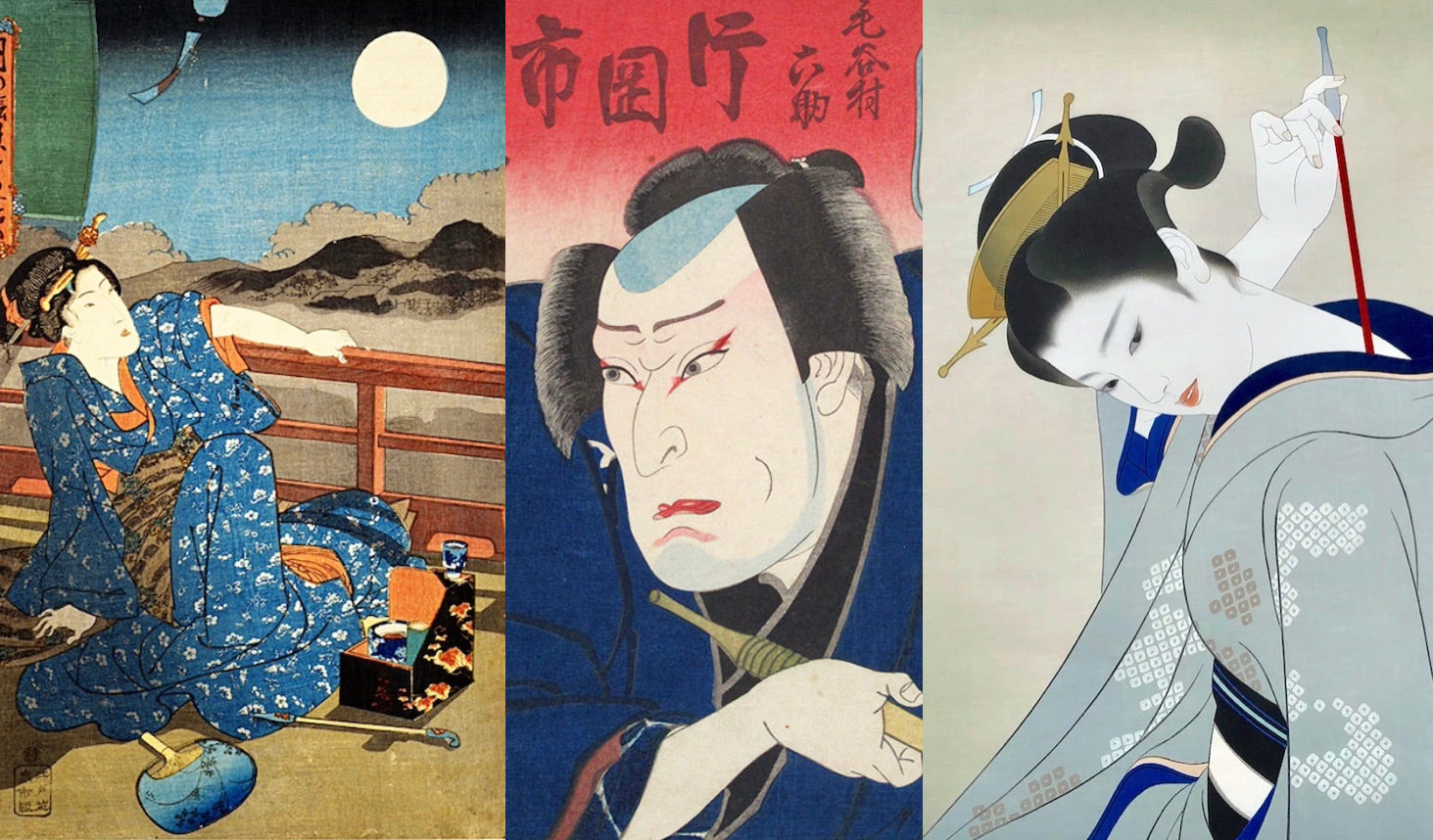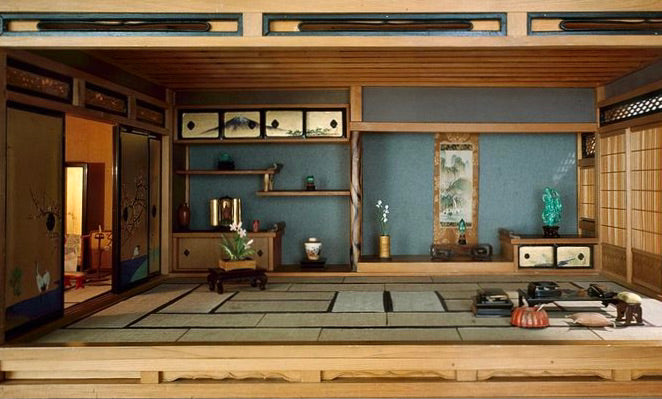It is not clear when tobacco was first introduced to Japan, but soon after the arrival, the custom of smoking seems to have spread quickly throughout the country. Kyoto planted tobacco seeds and inhaling smoke of its eaves became popular among them, and the practice of smoking began. Smoking was banned by the Shogunate because it was thought to be hazardous than beneficial, and some people hated tobacco because they believed smoking would bring evil. Tobacco at that time was not smoked in the form of a cigarette; leaves were finely shredded, and in the Edo Period (1603-1867), people in Japan began to use pipes called kiseru. Sagemono fashion items were for townsmen in the Edo period (1603-1868), which were specifically related to Netsuke, Inro, and Kiseru. Traditional Japanese garments robes called kosode and kimono had no pockets; however, men who wore them needed a place to store their personal belongings, such as pipes, tobacco, money, seals, or medicines, thus the production of Sagemono came about.
Kyoto and Tokyo were both important centers for the production of kiseru, (bamboo tobacco pipes), until World War II. Traditional Japanese tobacco, (kizami), was very finely chopped, in order to make it easier to pack into the small bowls of the kiseru. Kiseru pipes made in Kyoto were prized as the best throughout Japan. Kiseru styles are named from the shapes of the bow/shank, and mouthpiece. They are roughly divided into two styles: Joshin, that has shanks and mouthpieces with wide openings, and the Sekishu style which are uniform in width. Both styles had various shapes.

These bamboo stems used for pipes were often dyed red, black or amber, and some were painted by hand. The stem of the pipe are prepared by boiling and drying the bamboo was referred to as shinobe. Most bamboo came from Hakone in Shizuoka Prefecture. Although they are no longer commonly used for smoking tobacco, they are still highly valued as curios and vintage collectibles around the world.
Originally, kiseru were manufactured by specialized artisans, but eventually sword furniture makers, who had the highest metalwork skills, began to produce them. Naturally, kiseru bearing the makers’ names of specialized artisans, who outnumber those by sword furniture makers, but they fell short of the works by sword furniture makers in the carving skill, the variety of techniques, and the materials. By the government’s ban on carving of swords in 1876, sword furniture makers lost their jobs, were force to produce kiseru and other objects, including tobacco pouch fittings and netsuke, toggles, coordinating their work with the producers of tabako-bon.

Japanese forms of smoking accessories
Around the mid-Edo period, the Japanese wanted to start smoking outside their homes. To do so, and to carry their pipes easily developed different accessories like "tabako-ire”, (hanging tobacco-pouches), made of imported materials such as gilded leather, velvet, chintz batik, and wool; as well as deer skin with lacquer and brocade decoration), which would hang from the narrow sashes worn by men of the plebeian classes at the time. “Pocket" cases, carried in the upper folds of the kimono, were more practical for women, and for male members of the upper social strata. Tobacco pouches began as simple portable contains for small amounts of tobacco, but their usefulness and efficiency were increased when ways were devised to combine them with pipe-cases and other practical or ornamental components. During the Edo period, two general categories could be differentiated according to the ways in which they were worn.

History tells us that because of the laws surrounding smoking, people had to take lessons, which upon finishing, they would receive a "tabako-ire" reward. These were usually hung on the belt of the kimono, and thus they became a social sign, (young people could show them off and show everyone that ‘I'm adult’. It also became very fashionable to have a silver "nobe kiseru". It was an essential fashion accessory for young people from rich houses. The presence of kiseru in many woodblock prints of the Edo period attests to the importance of this object in the daily life in that period. Cigarettes and tobacco was imported from the West and Russia, as smoking increasingly in popular.
In addition, the decorative potential of smoking paraphernalia opened up new fields for the creative energies of craftsmen in numerous areas of applied art. In these and other ways, influences from tobacco made their mark upon early modern Japanese art, and society. They developed what was called a tabako-bon, (pipe-smoking tray or set), literally tobacco tray, usually consisting of a tray or a small portable chest with drawers on which were placed long pipes with metal bowls and mouthpieces. An ash-filled urn holding live charcoal embers, was included, and, along with a metal bowl to hold an ember for lighting the pipe; a container to hold ashes from the smoker's pipe, one or more containers of finely chopped tobacco; metal tongs; and paper for cleaning the pipes.

Kiseru Festival
This is anecdotal, but interesting: every year, on the first Sunday of September, an amazing Kiseru Festival called, “Kiseru Matsuri”, is held in the Ibaraki region, accompanied with Shinto rituals, in which men carry through the mountains a huge kiseru, (3.5-meters in length), which was crafted by the famous Murata factory, who wanted to offer this symbolic kiseru to the local deity. The factory was closing down the production of its famous kiseru because of limited interest and use. It is now a museum, housed in a group of traditional buildings from the Edo Period, and built in a style called, udatsu, which refers to the plaster covered extension to the front of the building, which helped prevent fires from spreading. This festival has been held every year on Mount Kaba-san, in Ishioka since 1954, after the tobacco crops in the area were "miraculously" saved from heavy hail.

Tsuyu (Rainy Season)
As a side note, during the rainy season, (more prosaically called tsuyu, also called baiu), it rains often and long, and even on days when it doesn't rain it is often cloudy, and the humidity is high, so houses and shops become damp and musty, even when the sliding doors were kept open. One of the chief ways people dealt with moldy smells was by burning tobacco leaves in the irori which is basically a traditional Japanese sunken hearth (fireplace), or lighting sticks of incense and standing them in ash-filled urns or bowls. Then, after the rainy season was over, they would take every damp object in the house out into the garden for sunning.

Segemono Paraphenalia



